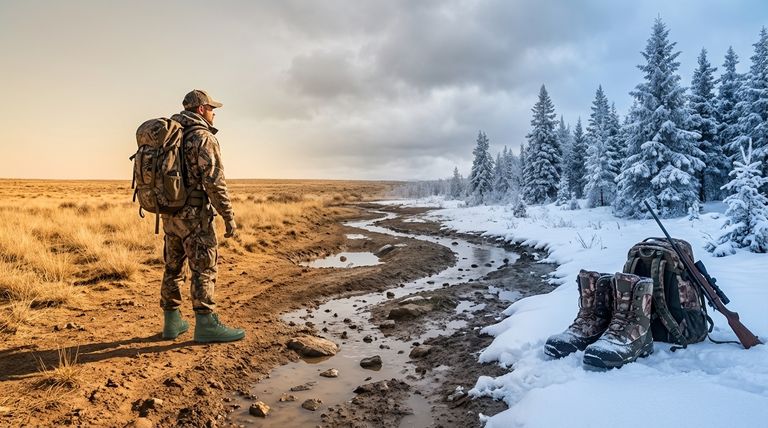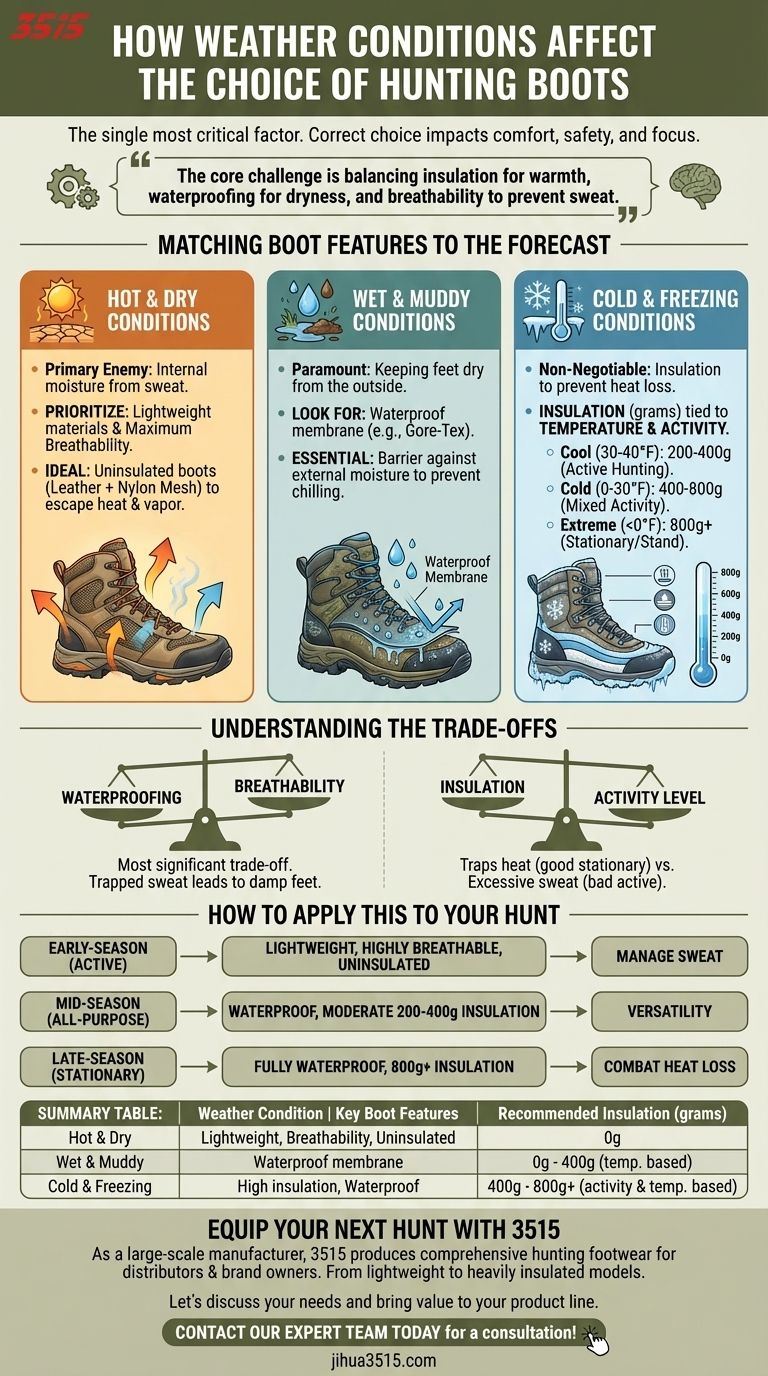Weather is the single most critical factor in selecting the right hunting boot. The correct choice directly impacts your comfort, safety, and ability to stay focused in the field. Hot weather demands lightweight, breathable boots, while wet conditions require waterproofing, and cold temperatures necessitate specific levels of insulation to prevent heat loss.
The right hunting boot is not just about keeping external weather out; it's about managing your internal climate. The core challenge is balancing insulation for warmth, waterproofing for dryness, and breathability to prevent sweat, which can be as detrimental as rain or snow.

Matching Boot Features to the Forecast
The environment dictates your gear. A boot that excels in one condition will likely fail in another. Understanding the primary features and how they align with the forecast is the first step to making an informed choice.
Hot and Dry Conditions
In warm weather, your primary enemy is internal moisture from sweat. Trapped sweat leads to blisters and discomfort.
Prioritize lightweight materials and maximum breathability. Uninsulated boots made from leather and nylon mesh panels are ideal as they allow heat and vapor to escape.
Wet and Muddy Conditions
When facing rain, snowmelt, or creek crossings, keeping your feet dry from the outside is paramount.
Look for boots with a waterproof membrane, like Gore-Tex. This technology is essential for creating a barrier against external moisture, keeping your feet dry and preventing the chilling effect of wet socks.
Cold and Freezing Conditions
In cold weather, your body loses significant heat through your feet, especially when stationary. Insulation is non-negotiable.
Boot insulation is measured in grams, and the amount you need is tied directly to the temperature and your activity level.
- For cool temperatures (30-40°F): 200-400 grams of insulation is sufficient for active hunting.
- For cold temperatures (0-30°F): 400-800 grams of insulation provides a good balance for mixed activity.
- For extreme cold (below 0°F): 800+ grams of insulation is necessary, especially for stationary hunting like in a blind or treestand.
Understanding the Trade-offs
No single boot is perfect for all conditions. Every design feature comes with a corresponding compromise that you must consider based on your specific hunting style.
Waterproofing vs. Breathability
This is the most significant trade-off in boot design. A fully waterproof boot is, by nature, less breathable.
Even the best waterproof membranes can trap some sweat inside, especially during strenuous activity in milder temperatures. This can lead to damp feet even when it isn't raining.
Insulation vs. Activity Level
Insulation is designed to trap heat. This is excellent when you are sitting still but can be a major liability when you are active.
Wearing a heavily insulated boot on a long hike or while stalking game can cause your feet to sweat profusely. That sweat will then make your feet feel cold and clammy the moment you stop moving.
How to Apply This to Your Hunt
Your choice should be a calculated decision based on the most likely scenario you'll face. Use these guidelines to select the right tool for the job.
- If your primary focus is early-season, active hunting: Prioritize lightweight, highly breathable, and uninsulated boots to manage sweat.
- If your primary focus is mid-season, all-purpose hunting: Choose a waterproof boot with a moderate 200-400 grams of insulation for versatility.
- If your primary focus is late-season, stationary hunting: Select a fully waterproof boot with 800 grams or more of insulation to combat heat loss.
Ultimately, selecting the right boot is about anticipating the conditions so you can focus on the hunt, not your feet.
Summary Table:
| Weather Condition | Key Boot Features | Recommended Insulation (grams) |
|---|---|---|
| Hot & Dry | Lightweight, maximum breathability, uninsulated | 0g |
| Wet & Muddy | Waterproof membrane (e.g., Gore-Tex) | 0g - 400g (based on temperature) |
| Cold & Freezing | High insulation, waterproof | 400g - 800g+ (depending on activity and temperature) |
Ready to equip your next hunt with the perfect boots?
As a large-scale manufacturer, 3515 produces a comprehensive range of hunting footwear for distributors, brand owners, and bulk clients. Our production capabilities encompass all types of boots, from lightweight, breathable designs for early season to heavily insulated, waterproof models for extreme cold.
We can help you source or develop the ideal hunting boots that match your target market's specific weather challenges. Let's discuss your needs and how we can bring value to your product line.
Contact our expert team today for a consultation!
Visual Guide

Related Products
- Factory-Direct Wholesale Canvas Boots with High-Traction Rubber Soles
- Premium Wholesale Waterproof Safety Boots High Performance Protection for Industrial Markets
- Customizable Anti-Smash Safety Boots for Wholesale & Private Label Manufacturing
- Custom Wholesale Leather Safety Boots Direct Factory Manufacturing
- High-Traction Suede Tactical Boots Wholesale & Custom Manufacturing
People Also Ask
- What should be avoided when storing boots with outsoles? Protect Your Investment from Dry Rot & Decay
- What role do slip-resistant rubber materials play in safety shoes? Ensuring Grip and Stability in Hazardous Workplaces
- What factors determine the slip resistance of rubber-soled shoes? Tread, Compound & Design Explained
- What types of work environments are hiker-style rubber outsoles best for? Ideal for Outdoor & Industrial Safety
- Why are rubber soles beneficial in cold-weather boots? Superior Traction & Waterproofing



















